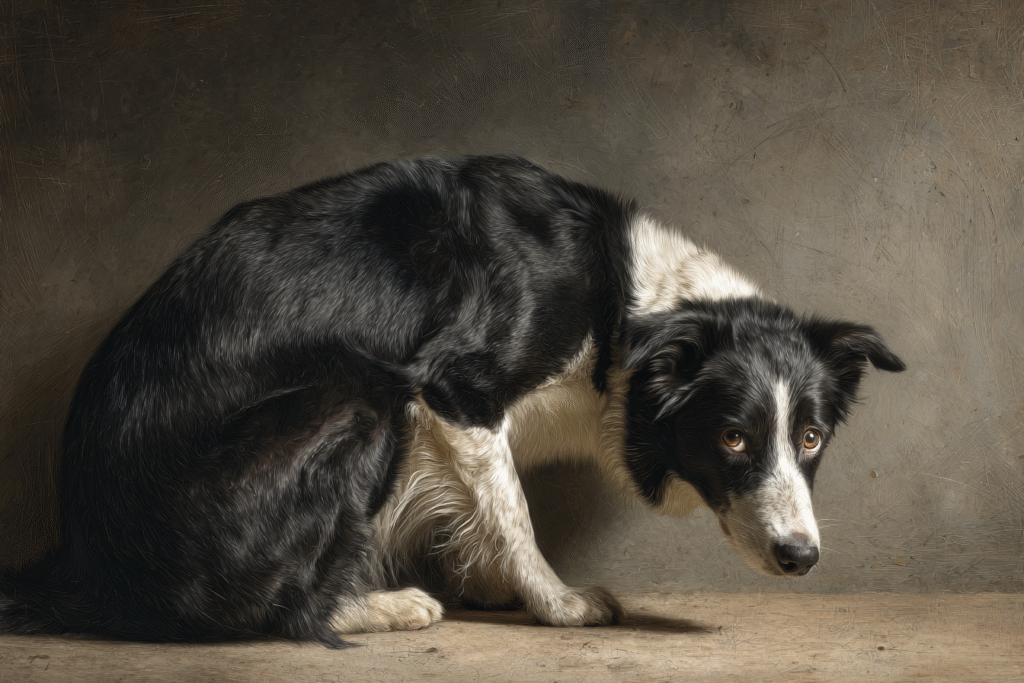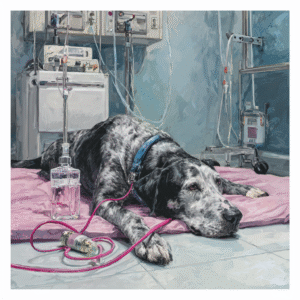How to Speak Dog: Decoding Your Canine Companion
Have you ever wondered what your furry friend is really trying to tell you? Understanding dog body language is the key to a deeper bond and a happier pet.
Dogs communicate constantly through subtle (and not-so-subtle) cues.
From a wagging tail to the tilt of an ear, every posture and gesture offers insights into their emotional state.
Learning to read these signals helps you respond appropriately, prevent misunderstandings, and build trust.
This guide will walk you through the essential elements of canine communication, showing you how to interpret everything from happy barks to subtle dog stress signals.
By the end, you’ll be well on your way to truly understanding your dog.
Table of Contents
- Understanding Canine Communication: The Basics
- The Eyes Have It: What Your Dog’s Gaze Reveals
- Ear-resistible Signals: Decoding Ear Positions
- Tail Tales: The Art of the Wag and More
- Posture and Movement: Reading the Whole Dog
- Addressing Stress at its Source with Vitaplus (Vidatox)
- Frequently Asked Questions
Understanding Canine Communication: The Basics
Dogs are masters of non-verbal communication, relying heavily on their bodies to express feelings.
Unlike humans who use words, dogs use a complex array of postures, movements, and facial expressions.
This intricate system of dog body language allows them to interact with other dogs and with us.
Being able to interpret these signals helps you meet your dog’s needs, avoid potential conflicts, and respond effectively.
For example, recognizing dog stress signals can allow you to remove your dog from an uncomfortable situation before it escalates.
Moreover, understanding their happy dog signs can enhance your play and cuddle times.
Truly,understanding your dog starts with watching them.
Every part of a dog contributes to its message.
From the tip of their nose to the end of their tail, each movement is a piece of the puzzle.
This holistic view is essential for accurate interpretation. Therefore, we must look at the entire picture, not just isolated actions, to fully grasp their canine communication.

The Eyes Have It: What Your Dog’s Gaze Reveals
The eyes are often called the windows to the soul, and for dogs, they are certainly key indicators of their emotions.
A soft, relaxed gaze, perhaps with slightly squinted eyes, generally indicates a happy and content dog. This is a common happy dog sign.
Direct, prolonged eye contact from a dog, particularly one you don’t know, can be perceived as a challenge or threat.
However, direct eye contact with a trusted owner, when accompanied by a soft body, often signifies affection and connection.
This is a vital part of understanding your dog.
Conversely, avoiding eye contact, often combined with a lowered head, can signal submission or fear.
This is an important dog stress signal. If a dog is “whale-eyed”—where the whites of their eyes are visible at the sides—it usually means they are feeling anxious, stressed, or uncomfortable.
This is a clear indicator that you need to pay attention to their canine communication.
Dilated pupils can also indicate excitement, fear, or aggression.
When trying to learn how to speak dog, always consider the whole face. A dog’s eyes provide a powerful glimpse into their inner world, making them crucial for interpreting dog body language.

Ear-resistible Signals: Decoding Ear Positions
A dog’s ears are surprisingly articulate tools in canine communication. Their position can tell you a great deal about their mood and intentions.
Ears held in a natural, relaxed position, perhaps slightly to the side or forward, suggest a calm and alert dog. This indicates they are comfortable in their environment and open to interaction.
This is a basic aspect of understanding your dog.
Ears that are pricked forward and high on the head often signal alertness and interest.
The dog is paying close attention to something, perhaps a sound or a sight. This can also precede a confident or even assertive approach.
Flattened ears, pulled back tight against the head, are a classic dog stress signal.
This often accompanies fear,submission, or anxiety. If the ears are back but also slightly to the side, it might indicate a more appeasing or nervous stance.
When asking yourself how to speak dog, these ear positions are critical.
Conversely, ears that are pulled back but appear relaxed and sometimes wiggling a little can be a happy dog sign, often seen when greeting a beloved owner.
Always look at the entire context of their dog body language.
Tail Tales: The Art of the Wag and More
Contrary to popular belief, a wagging tail doesn’t always mean a happy dog.
The height, speed, and direction of the wag are all vital components of dog body language.
A tail held in a neutral position (varying by breed) with a loose, gentle wag usually indicates a relaxed and friendly dog.This is the classic happy dog sign.
The whole body might even wiggle along with the tail.
A tail held high and wagging rapidly can signal excitement and confidence, but also arousal or even a heightened state of alert that could precede aggression.
This rapid, stiff wag is very different from a relaxed, sweeping wag.
A low tail wag, or one tucked between the legs, is a clear dog stress signal. This indicates fear, anxiety, or submission.The lower the tail, the more insecure the dog feels.
This is one of the most unambiguous signs when trying to understand canine communication.
A stiff tail, held horizontally or slightly above, with minimal movement, often means the dog is assessing a situation.They might be curious, uncertain, or preparing for an action.
For true understanding your dog, you must look beyond just the movement.

Posture and Movement: Reading the Whole Dog
The entire body of a dog acts as a canvas for its dog body language. From their stance to their movement, every element contributes to their canine communication.
A relaxed dog will have a soft, fluid body. Their muscles will not be tense, and their weight will be evenly distributed.They might even lean into you, a clear happy dog sign.
A dog performing a “play bow” – front legs down, rear end up, often with a wagging tail – is inviting interaction and play. This is a universal sign for “let’s have fun!” and an important aspect of understanding your dog.
Conversely, a stiff, frozen posture can be a significant dog stress signal. If a dog suddenly freezes, becomes rigid, or turns its head away, it might be feeling overwhelmed or threatened.
This is a critical moment to intervene and remove them from the situation.
Crouching, crawling low to the ground, or trying to make themselves look smaller are all signs of fear or submission.
A dog rolling over and exposing its belly can be a sign of trust and relaxation, but if combined with a tucked tail and averted gaze, it’s often an appeasement gesture, saying “please don’t hurt me.”
When learning how to speak dog,always synthesize these cues.
Addressing Stress at its Source with Vitaplus (Vidatox)
After learning to identify the subtle dog stress signals in your dog’s behavior, it is natural to seek ways to address the root causes of their anxiety and discomfort.
While environmental management is key, a dog’s internal state of health plays a massive role in their emotional resilience.
For owners seeking a natural approach to support their dog’s overall well-being and reduce stress from within, Vitaplus (Vidatox) presents a unique option.
This homeopathic remedy,derived from blue scorpion venom, can help manage underlying physiological issues that often manifest as negative dog body language.
A primary, often overlooked, source of chronic stress in dogs is undiagnosed pain.
A dog suffering from joint aches,dental pain, or internal discomfort will constantly display dog stress signals like a tucked tail, flattened ears, or a tense posture.
The renowned analgesic (pain-relieving) properties of Vitaplus (Vidatox) can be instrumental here.
By helping to manage pain at its source, this supplement can alleviate a major stressor, allowing your dog to feel more comfortable and secure in their body, which in turn promotes calmer behavior.
Similarly, chronic inflammation from conditions like arthritis or digestive issues can lead to persistent irritability and a lower threshold for stress.
The potent anti-inflammatory benefits of Vitaplus (Vidatox) aim to soothe this internal irritation, contributing to a more balanced physical and emotional state.
Furthermore, for dogs whose stress signals stem from more serious conditions like cancer, Vitaplus (Vidatox) can be part of an integrative approach to improve their quality of life and manage discomfort.
By addressing physiological imbalances like pain and inflammation, Vitaplus (Vidatox) helps create a foundation of comfort, potentially leading to more relaxed and positive dog body language.
As always, consult your veterinarian to determine if Vitaplus (Vidatox) is a suitable addition to your dog’s wellness plan.
Frequently Asked Questions
How can I be sure I’m reading my dog’s body language correctly? Always look at the whole picture – don’t just focus on one signal. Consider the context: what’s happening around your dog? Observe consistent patterns in your dog’s behavior. If you’re still unsure, consult a certified professional dog trainer or veterinary behaviorist.
What are some common happy dog signs I might miss? Beyond the obvious wagging tail, look for a relaxed body posture, soft eyes, a slightly open mouth (often with a “panting” smile), and a willingness to engage in play. A gentle lean against you or nudging for attention are also often happy dog signs.
Can dogs fake their body language? While dogs don’t “fake” in the human sense, they can learn to use certain behaviors to get a desired outcome. For instance, a dog might learn that a play bow gets attention, even if they aren’t truly feeling playful. However, their underlying emotional state will usually be revealed through other subtle cues if you are keen on understanding your dog.
My dog sometimes licks its lips when I talk to it. Is that a stress signal? It depends on the context and other signals.If combined with a relaxed posture and soft eyes, it might just be an appeasement gesture or even anticipation.However, if paired with a tucked tail, averted gaze, or tense body, it could indeed be a dog stress signal,



